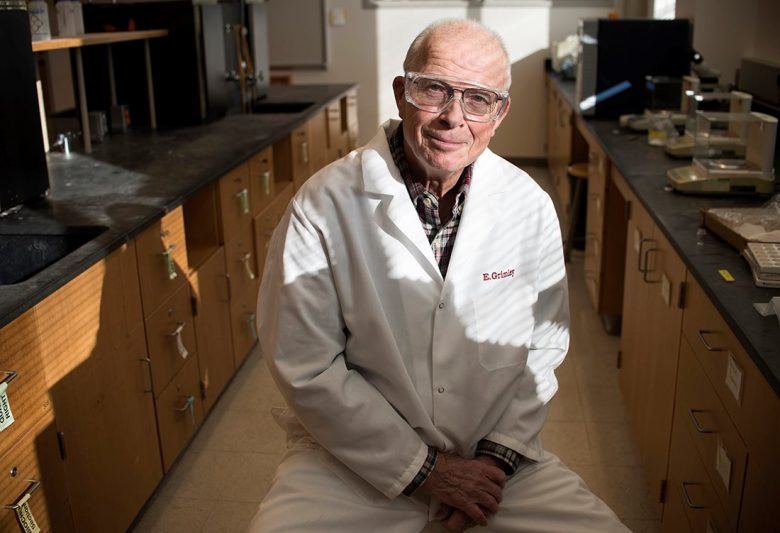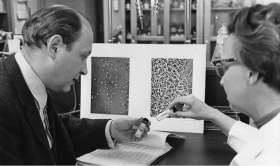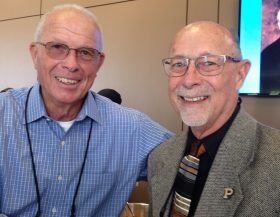Serendipity in the lab leads to life-saving discoveries for Professor Emeritus of Chemistry Gene Grimley.

Gene Grimley’s work on what would go on to be one of the most successful cancer chemotherapy drugs in history started with a 3×5 index card.
It was on that card more than 50 years ago that Grimley, professor emeritus of chemistry at Elon, found a job listing from the biophysics lab at Michigan State University that was seeking a chemist. Then a graduate student, Grimley landed the job and began the work that would play an integral part in the eventual Food and Drug Administration approval of cisplatin, a groundbreaking anti-cancer drug that has since saved countless lives.
Grimley was able to revisit the role he played in the development of cisplatin this past summer as he returned to Michigan State University to attend The Cisplatin Celebration & Cancer Research Symposium and reconnect with former colleagues. The 2018 gathering drew more than 200 people to mark the 40th anniversary of the FDA’s approval of cisplatin as the cancer-fighting drug Platinol, which is commercially produced by Bristol-Myers Squibb. “It was exciting to reunite with researchers on the team along with dozens of chemists, physicists and oncologists from around the world who took those early findings and worked to develop this most-successful chemotherapy remedy for cancer.” Grimley says. “My career went in the direction it did because of this project.”
Cisplatin is now known as “the penicillin of cancer drugs.” Along with being one of the first platinum-containing drugs to treat many cancers including ovarian, testicular, esophageal, bladder, head, neck, lung and stomach cancers, brain tumors and neuroblastoma, it has proven to be one of the most effective and most widely prescribed anti-cancer drugs. Bruce Chabner, former director of the National Cancer Institute, estimates that 40 to 50 percent of all cancer patients undergoing chemotherapy receive a platinum-containing drug. “It would be frightening to imagine the current status of cancer treatment without this essential drug,” Chabner wrote in a 2010 article for the American Association for Cancer Research.

Grimley’s challenge was to determine what chemical substance within the experiment was causing cell division to stop and the bacteria to elongate and then die. He was able to isolate and identify that a platinum compound was responsible. Grimley and the team determined that in creating the electrical field in the solution, the use of platinum for the electrodes had led to the creation of a water-soluble platinum compound that Grimley then identified as what would become the first platinum anti-cancer agent. The compound quickly led to the discovery of a second platinum anti-cancer agent, cisplatin. Although both platinum compounds were very effective, cisplatin was the more effective of the two.
Serendipity is a common element in the discovery process, and Grimley points to multiple points along the path to discovering cisplatin when it played a role. Often it lay in the decision to examine what appeared to be a failure only to find it to be a breakthrough. First was the decision to examine the solution after the electric field experiments appeared to have failed, rather than just dumping that solution down the drain. Without that extra step, Grimley wouldn’t have discovered what was causing the bacteria to stop dividing and elongate.
Next, a solution of a platinum test compound had bleached after sitting in the sun for several days in what was originally thought to be an error and a waste. Van Camp, the project’s microbiologist, decided not to discard the solution, and instead discovered in it the evidence of a photochemical reaction that produced the exact species responsible for E. coli’s filamentous growth that was isolated by Grimley.
Grimley’s work was key to the eventual application of cisplatin as a cancer-fighting drug, but FDA approval was still more than a decade away. He left Michigan State in 1965 to complete his doctoral degree and then hold his first academic position, at Mississippi State, all before cisplatin “hit the big time.” Grimley arrived at Elon in 1987, where he spent 30 years and played a key role in building the university’s Department of Chemistry before retiring in 2017. “Research is like making your way in fog across a stream on a series of stepping stones,” Grimley says. “I was just fortunate to be able to provide the next steps.”

In East Lansing, Grimley reconnected with many of his old research colleagues. Three of the five key players in the lab in the mid-1960s were able to come back together after so many years apart. “It was so great to see them and to see what they have done with their lives,” Grimley says. James Hoeschele of Eastern Michigan University, a former colleague who would co-develop a less toxic platinum anti-cancer drug, and Grimley are now co-authoring a history of the development of platinum chemotherapeutics.
For Grimley, the experience at Michigan State solidified his interest in inorganic chemistry and his extensive further research on the synthesis and characterization of platinum compounds. And for that, he is eternally grateful. “I learned so much about the impact of the work I had done that I just didn’t realize,” he says. “This really was such a fantastic opportunity in my life.


